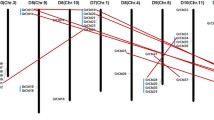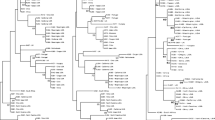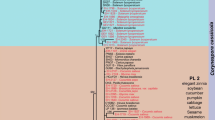Abstract
Corynespora cassiicola is a species of fungus that is a plant pathogen of many agricultural crop plants, including severe target spot disease on cucumber. Cassiicolin is an important effector of pathogenicity of this fungus. In this study, we collected 141 Corynespora isolates from eighteen hosts, and the casscolin gene was detected in 82 C. cassiicola strains. The deduced protein sequences revealed that 72 isolates contained the Cas2 gene, two strains from Gynura bicolor harboured the Cas2.2 gene, and 59 isolates without a cassiicolin gene were classified as Cas0. Phylogenetic analyses was performed for the 141 isolates using four loci (ITS, ga4, caa5, and act1) and revealed two genetic clusters. Cluster A is composed of four subclades: subcluster A1 includes all Cas2 isolates plus 18 Cas0 strains, subcluster A2 includes the eight Cas5 isolates and one Cas0 isolate, and subclusters A3 and A4 contain Cas0 strains. Cluster B consists of 21 Cas0 isolates. Twenty-two C. cassiicola strains from different toxin classes showed varying degrees of virulence against cucumber. Cas0 or Cas2 strains induced diverse responses on cucumber, from no symptoms to symptoms of moderate or severe infection, but all Cas5 isolates exhibited avirulence on cucumber.
Similar content being viewed by others
Change history
23 August 2018
In the online published article by Wu <Emphasis Type="Italic">et al.</Emphasis> since 30 July 2018, the figure 4 is unfortunately incorrect. The figure 4 should be corrected as below.
References
Barthe, P., Pujade-Renaud, V., Breton, F., Gargani, D., Thai, R., Roumestand, C., and De, L.F. 2007. Structural analysis of cassiicolin, a host-selective protein toxin from Corynespora cassiicola. J. Mol. Biol. 367, 89–101.
Bendtsen, J.D., Nielsen, H., Von, H.G., and Brunak, S. 2004. Improved prediction of signal peptides: Signalp 3.0. J. Mol. Biol. 340, 783–795.
Cai, L., Ji, K.F., and Hyde, K.D. 2006. Variation between freshwater and terrestrial fungal communities on decaying bamboo culms. Antonie van Leeuwenhoek 89, 293–301.
Carbone, I. and Kohn, L.M. 1999. A method for designing primer sets for speciation studies in filamentous ascomycetes. Mycologia 91, 553–556.
De Lamotte, F., Duviau, M.P., Sanier, C., Thai, R., Poncet, J., Bieysse, D., Breton, F., and Pujade-Renaud, V. 2007. Purification and characterization of cassiicolin, the toxin produced by Corynespora cassiicola, causal agent of the leaf fall disease of rubber tree. J. Chromatogr. B Analyt. Technol. Biomed. Life Sci. 849, 357–362.
Déon, M., Bourré, Y., Gimenez, S., Berger, A., Bieysse, D., de Lamotte, F., Poncet, J., Roussel, V., Bonnot, F., Oliver, G., et al. 2012a. Characterization of a cassiicolin-encoding gene from Corynespora cassiicola, pathogen of rubber tree (Hevea brasiliensis). Plant Sci. 185–186, 227–237.
Déon, M., Fumanal, B., Gimenez, S., Bieysse, D., Oliveira, R.R., Shuib, S.S., Breton, F., Elumalai, S., Vida, J.B., Seguin, M., et al. 2014. Diversity of the cassiicolin gene in Corynespora cassiicola and relation with the pathogenicity in Hevea brasiliensis. Fungal. Bio-UK 118, 32–47.
Déon, M., Scomparin, A., Tixier, A., Mattos, C.R.R., Leroy, T., Seguin, M., Roeckel-Drevet, P., and Pujade-Renaud, V. 2012b. First characterization of endophytic Corynespora cassiicola isolates with variant cassiicolin genes recovered from rubber trees in Brazil. Fungal. Divers. 54, 87–99.
Dixon, L.J., Schlub, R.L., Pernezny, K., and Datnoff, L.E. 2009. Host specialization and phylogenetic diversity of Corynespora cassiicola. Phytopathology 99, 1015–1027.
Farr, D.F., Rossman, A.Y., Palm, M.E., and McCray, E.B. 2007. Fungal databases. Systematic Botany and Mycology Laboratory, ARS, USDA. Retrieved Dec 13, from https://doi.org/nt.arsgrin.gov/fungaldatabases/.
Fernando, T.H.P.S., Jayasinghe, C.K., Wijesundera, R.L.C., and Siriwardana, D. 2009. Variability of hevea isolates of Corynespora cassiicola from Sri Lanka. J. Plant Dis. Protect. 116, 115–117.
Groenewald, S., Van, D.B.N., Marasas, W.F., and Viljoen, A. 2006. The application of high-throughput AFLP’s in assessing genetic diversity in Fusarium oxysporum f. sp. cubense. Mycol. Res. 110, 297–305.
Liu, X.M. 2012. Ph. D. thesis. Coloning and functional identification of a mitogen-activated protein kinase gene (CCK1) and toxin encoding gene (ct) of Corynespora cassiicola-the pathogen of Corynespora leaf fall disease of Hevea brassiliensis. Hainan University, Haikou, Hainan, China.
Liu, X.B., Li, B.X., Chen, S., and Huang, G.X. 2016. Diversity and pathogenicity of the cassiicolin gene in Corynespora cassiicola of rubber tree in China. Chinese J. Tropic. Crops 37, 1969–1973.
Nghia, N.A., Kadir, J., Sunderasan, E., Abdullah, M.P., Malik, A., and Napis, S. 2008. Morphological and inter simple sequence repeat (ISSR) markers analyses of Corynespora cassiicola isolates from rubber plantations in Malaysia. Mycopathologia 166, 189–201.
Promputtha, I., Lumyong, S., Dhanasekaran, V., Mckenzie, E.H., Hyde, K.D., and Jeewon, R. 2007. A phylogenetic evaluation of whether endophytes become saprotrophs at host senescence. Microb. Ecol. 53, 579–590.
Qi, Y., Xie, Y., Zhang, X., Pu, J., Zhang, H., Huang, S., and Zhang, H. 2009. Molecular and pathogenic variation identified among isolates of Corynespora cassiicola. Mol. Biotechnol. 41, 145–151.
Qi, Y.X., Zhang, X., Pu, J.J., Liu, X.M., Lu, Y., Zhang, H., Zhang, H.Q., Lv, Y.C., and Xie, Y.X. 2011. Morphological and molecular analysis of genetic variability within isolates of Corynespora cassiicola from different hosts. Eur. J. Plant Pathol. 130, 83–95.
Saha, T., Kumar, A., Sreena, A.S., Joseph, A., Jacob, C.K., Kothandaraman, R., and Nazeer, M.A. 2000. Genetic variability of Corynespora cassiicola infecting Hevea brasiliensis isolated from the traditional rubber growing areas in India. Indian J. Nat. Rubber Res. 13, 1–10.
Schoch, C.L., Crous, P.W., Groenewald, J.Z., Boehm, E.W., Burgess, T.I., de Gruyter, J., de Hoog, G.S., Dixon, L.J., Grube, M., Gueidan, C., et al. 2009. A class-wide phylogenetic assessment of Dothideomycetes. Stud. Mycol. 64, 1–15.
Shimomoto, Y., Sato, T., Hojo, H., Morita, Y., Takeuchi, S., Mizumoto, H., and Hikichi, Y. 2011. Pathogenic and genetic variation among isolates of Corynespora cassiicola in Japan. Plant Pathol. 60, 253–260.
Shuib, S.S., Deon, M., Mahyuddin, M.M., Izhar, A., Fumanal, B., Sunderasan, E., and Pujade-Renaud, V. 2015. Cassiicolin genes among Corynespora cassiicola isolates from rubber plantations in Malaysia. J. Rubb. Res. 18, 109–126.
Silva, W.P.K., Deverall, B.J., and Lyon, B.R. 1998. Molecular, physiological and pathological characterization of Corynespora leaf spot fungi from rubber plantations in Sri Lanka. Plant Pathol. 47, 267–277.
Tamura, K. and Nei, M. 1993. Estimation of the number of nucleotide substitutions in the control region of mitochondrial DNA in humans and chimpanzees. Mol. Biol. Evol. 10, 512–526.
Tamura, K., Stecher, G., Peterson, D., Filipski, A., and Kumar, S. 2013. MEGA6: Molecular evolutionary genetics analysis version 6.0. Mol. Biol. Evol. 30, 2725–2729.
Thompson, J.D., Gibson, T.J., Plewniak, F., Jeanmougin, F., and Higgins, D.G. 1997. The CLUSTAL_X windows interface: flexible strategies for multiple sequence alignment aided by quality analysis tools. Nucleic Acids Res. 25, 4876–4882.
White, T.J., Bruns, T.D., Lee, S.B., Taylor, J.W., Innis, M.A., Gelfand, D.H., and Sninsky, J.J. 1990. Amplification and direct sequencing of fungal ribosomal RNA genes for phylogenetics, pp. 315–322. In Innis, M.A., Gelfand, D.H., Sninsky, J.J., and White, T.J. (eds.), PCR Protocols: A guide to methods and applications. Academic Press Inc., New York, USA.
Author information
Authors and Affiliations
Corresponding author
Additional information
An erratum to this article is available at https://doi.org/10.1007/s12275-018-8580-7.
Rights and permissions
About this article
Cite this article
Wu, J., Xie, X., Shi, Y. et al. Variation of cassiicolin genes among Chinese isolates of Corynespora cassiicola. J Microbiol. 56, 634–647 (2018). https://doi.org/10.1007/s12275-018-7497-5
Received:
Revised:
Accepted:
Published:
Issue Date:
DOI: https://doi.org/10.1007/s12275-018-7497-5




